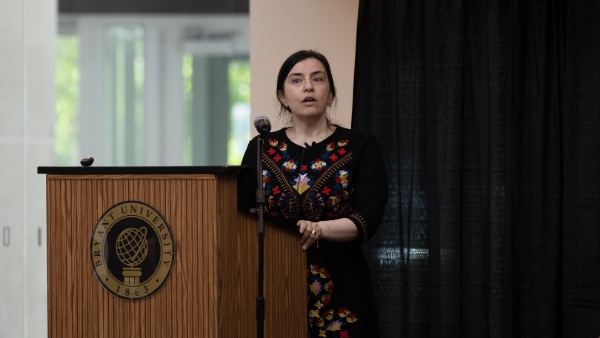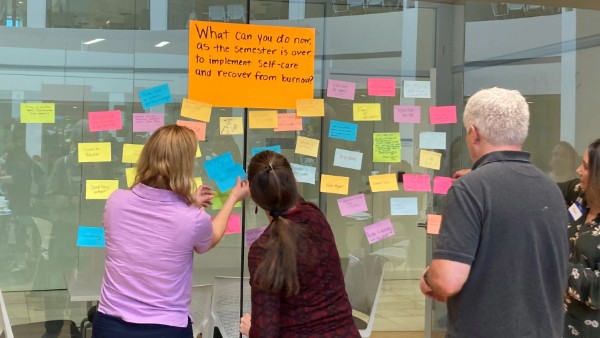The Academic Innovation Center’s Innovation Forum was buzzing with chatter on May 21 as educators representing the College of Arts and Sciences, College of Business, and School of Health and Behavioral Sciences gathered for the 7th annual Teaching Summit. Organized by Bryant’s Center for Teaching Excellence (CTE), the yearly event brings faculty together to exchange ideas and support one another.
This spring’s summit addressed the burnout students are experiencing nationally and highlighted ways that Bryant educators can proactively assist students in the classroom and through external resources.
“I look forward to hearing your ideas to support our goal of personal and academic development of both our students and our faculty,” said Provost and Chief Academic Officer Rupendra Paliwal, Ph.D., who welcomed attendees to the event.
Delivering the summit’s keynote, Mays Imad, Ph.D., an associate professor of biology at Connecticut College whose research focuses on the social determinants of student success, started with a personal story. Born and raised in Baghdad, Iraq, Imad left her home country around age 14 and became a refugee. Being far away from her homeland, starting high school, and watching the destruction of her country, Imad would enter class feeling fragmented.
“It was my teachers and professors who helped me put my pieces back together,” said Imad, noting that they helped her to learn and thrive. “They couldn’t take away my pain or trauma, but they let me know that they saw me in the most subtle yet persistent ways.”
Today, there are many causes to students’ burnout and exhaustion across America, including the pandemic, the threat of school shootings, climate change, loneliness, and not having a sense of self.
“The sense of self is really impacting students since they spent most of the past few years in isolation,” Imad said. “If we look at the neuroscience of loneliness, it’s part of our survival to be connected with others.”
She noted that there are different dimensions of burnout: feeling emotionally and physically exhausted; having a sense of detachment or depersonalization; thinking that you’re always behind or not making progress; and experiencing compassion fatigue.

Focusing on actionable steps, Imad asked educators to think about how they could cultivate spaces within the university so students would continue to thrive as well as how faculty could help students feel like they have a sense of control or agency. She noted that teaching students about the physiological effects of burnout and being in a “survival brain” versus a “learning brain” would aid them in understanding why they may now lack motivation that wasn’t apparent in the past.
“When our brain has a sensory overload, we shut down right away,” Imad said.
Following Imad’s presentation, CTE faculty fellows tasked educators with considering the concepts Imad covered and developing measures they could take to foster recovery for their students, as well as themselves. Ideas included everything from reserving time for mindful moments and having class outdoors to occasionally bringing in snacks and creating a class playlist to build community.
With brainstorming in action, Bryant University President Ross Gittell, Ph.D., joined attendees and commended them for taking the time — just three days after undergraduate Commencement — to discuss pedagogy, teaching, and overcoming the challenges that today’s students are facing. While the pandemic has impacted education nationally, he highlighted that data on Bryant’s Class of 2023 (students who were in their first year of college when COVID-19 began) show that they have done very well post-graduation.
“It speaks to the excellence we have, and we wouldn't have these outcomes for students without the work of faculty,” said Gittell.
Following Gittell’s remarks, the Teaching Summit featured a faculty and staff panel on disruption and distraction in the age of interrupted learning. Currently, on the national scale, faculty have reported an increase in distraction and disengagement within the classroom. With this behavior partially linked to limited socialization during the pandemic, general cultural shifts, and the increase of precarity in the world, Bryant experts discussed proactive strategies faculty could implement to re-engage students.

For Inge-Lise Ameer, Ed.D., vice president of student affairs/dean of students and chief diversity officer, re-engaging with students in her general education course included a bit of culinary flair.
“I come from a very large Middle Eastern family where food is everything and leads to conversation. I started offering a light dinner before class started if students wanted to come,” said Ameer, noting that undergrads frequently joined and connected with their peers.
In the second panel, faculty provided advice on how they have created successful connections with students in the classroom.
“Instead of leading with content and this is what we need to produce, I've started to lead with relationship building, especially for first-year students who may have felt disconnected to instructors over the years from being on Zoom,” said History, Literature, and the Arts Lecturer and interim coordinator of First-Year Writing Carrie Kell.
Marketing and Management Lecturer Mehreen Pasha added that she often builds community in the classroom by taking the time to chat with students before and after class. Additionally, to keep students engaged in course material, her key is to keep the class’s momentum going. For instance, a 50-minute session will consist of a 20- to 25-minute lecture, 15-minute visual presentation, and 10-minute activity.
“I want to leave them feeling eager and excited about what we’re going to do next class,” Pasha concluded.
Delivering the closing remarks, CTE Director Terri Hasseler, Ph.D., asked educators to reflect one last time on what they learned from the day and what they had found most valuable. As faculty left with the ideas they’d hastily written in notebooks and on sticky notes, you could see the gears turning in their minds as they thought about how they could approach the next academic year and help students thrive.